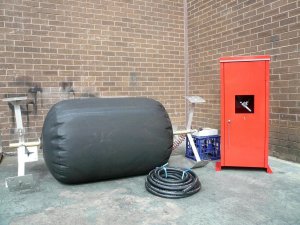Pipeline testing, maintenance and safety
Wednesday, 14 October, 2009
Maintenance of pipelines can be a tricky business. Sealing and testing operations need to be conducted not only with complete safety and environmental security but also with considerable speed, to maintain flows of liquids and gases.

One method of stopping and sealing involves inflatable pipe stoppers that can be rapidly deployed, easily transported and applied in remote, temporary and permanent industrial situations.
The Pronal inflatable pipe stoppers are used for maintenance, testing and emergency tasks in applications as diverse as oil and gas delivery, industrial and municipal water and wastewater, and pollution prevention in mining energy projects. One of the latest stoppers employed in Australasia is a custom-fabricated OFR type, to fit a pipe with an inside diameter of 900 mm. Multi-sized stoppers are available in an expanded range of spanning pipes from 45-2115 mm diameter in stock sizes and up to 3000 mm for customised types. Different ranges respond to the needs of particular industries and pressure requirements, with VPE and ORJ types being used for pressures up to 1 bar and OPV types for pressures up to 3 bar. Higher pressure stoppers are also available.
“The common factor with maintenance, testing and emergency situations is that they need stoppers that can be rapidly and securely deployed to provide primary or secondary safety and environmental security,” says Air Springs Supply National Manager Simon Agar.
“Sometimes the stoppers are permanently located in pipelines for instant remote inflation with compressed air or other gas where there is a risk of toxic runoff at different stages of production, or where spillages occur. In other instances they are used to seal off sections of pipe where leaks are occurring, serving the dual role of enabling pressurisation of that section so leaks can be detected, then protecting the men in the pipeline from any product flows while they work to fix the problem.”
Inflated at the specified pressure and with a back-pressure of up to 1 bar for standard types (10 m water column), each stopper can be used within a range of pipe diameters. For example, a range of just four stoppers is needed to span the 100-1200 mm diameter pipe sizes.
Sampling gases and volatile liquids: essential strategies
Following gas sampling best practices can improve product output and reduce fugitive emissions.
Planetary gearbox supports global success of composting solution
New Zealand company Global Composting Solutions is having international success with its...
5 things to consider before implementing a UPS
UPS systems play a vital role in the health of your control cabinet: consider these five things...









